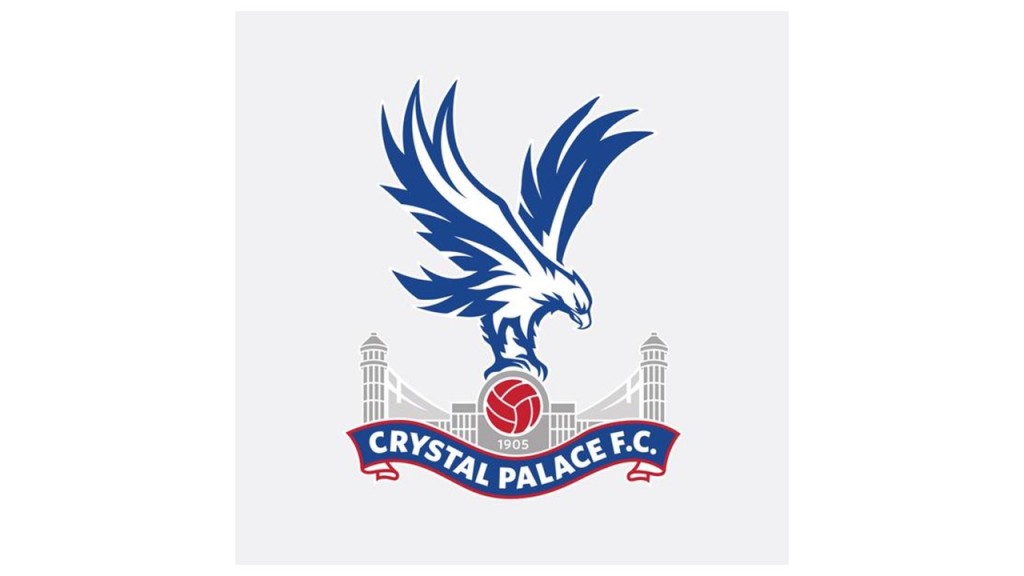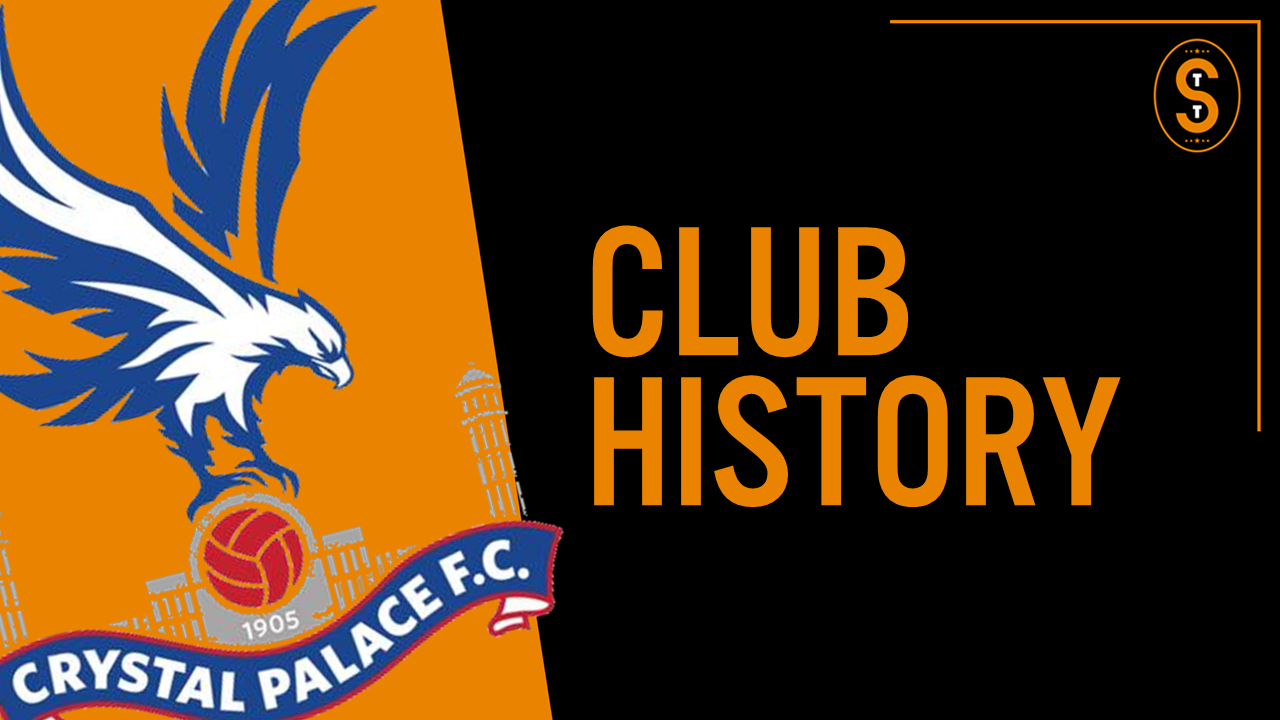Welcome to the Soccer Tavern, where we’re discussing the history, culture, and philosophy of the beautiful game. My name is Dave and in this series of videos, we’re discussing the history of soccer clubs around the world. In this video, we’re talking about Crystal Palace Football Club. Pull up a seat and let’s start the discussion.
Crystal Palace FC is located in the southern part of the city of London. London is located in the southern-central part of England in the United Kingdom. Palace currently play in the Premier League. The club’s home ground is called Selhurst Park, which was opened in 1924 and holds 26,309 people.
Origin
Crystal Palace FC were officially formed in 1905, but the club can trace its origin to a club formed in 1861. Palace’s story begins with a famous glass and iron palace nicknamed the Crystal Palace that was built for the Great Exhibition of Hyde Park in 1851 in London. It was moved to South London a few years later and converted to a theme park/tourist attraction. Employees of the Crystal Palace formed a team by that name in 1861. That club competed for 15 years including in the inaugural FA cup competition in 1871 but that club dissolved in 1876.
Matches were still played at the Crystal Palace grounds even after the club’s dissolution including all FA Cup finals from 1895 to 1914. By 1904, the Crystal Palace ground owners decided to form a club. When they applied to join the FA, they were rejected on the basis that they’d have an unfair home advantage in the FA cup.
The owners formed a separate company and club that would lease the Crystal Palace ground for its home matches, which for some reason was good enough for the FA. Not sure why that solved the homefield advantage issue, but the FA accepted Crystal Palace in 1905 into the 2nd division of the Southern League.
Nicknames
The club’s nicknames are (1) Palace, (2) The Glaziers, and (3) The Eagles.
The Palace nickname is derived from the club’s name.
The Glaziers nickname was a reference to the actual Crystal Palace structure that the club played near. The building was a giant iron & glass structure that often required maintenance. Glaziers are glassworkers and these workers often attended Palace matches. Additionally, the original Crystal palace formed in the 1860s had actual Glaziers as players on the squad, hence the nickname sticking.
The Glazier nickname was used from the early days of the club up to 1973. In ’73, Malcolm Allison took over as manager and wanted to change the nickname and culture of the club. He chose the Eagles as a nickname in reference to Benfica, the Portuguese club who was one of the most successful clubs in Europe at that time. Palace have been called the Eagles ever since.
Crest
With the nickname change to Eagles, the club updated its crest in 1973.
Prior to 1973, the club used various crests that usually included the initials CPFC, the words Crystal Palace, and/or an image of the Crystal Palace building.

The crest since the nickname change to Eagles in the 70s has been fairly similar to the current crest.
Today’s crest is an aggressive looking Eagle landing on a soccer ball in front of the Crystal Palace building and its famous towers that have since been destroyed by fire and WWII. The words Crystal Palace FC are in a scroll at the bottom.
It’s a pretty straight forward crest.
Important Events
I’d like to talk about 3 important events in the Eagles’ history.
We’ve already mentioned him, but Malcolm Allison’s appointment in April 1973 was instrumental in shaping the modern branding of Crystal Palace that we know today. He changed the kits/jerseys from the Aston Villa inspired colors that the club had worn for nearly all of its existence to FC Barcelona inspired colors due to Barcelona’s European success at the time. We’ve already discussed the nickname change to Eagles which has shaped the club’s modern Crest. Allison didn’t have much on field success, but was instrumental in shaping the branding of Palace that we know & recognize today.
Skipping ahead a few decades, the next event I’d like to discuss happened on June 1, 2010. On this date, Steve Parish led a consortium of 3 other investors who were all lifelong Palace fans to rescue the club from administration (bankruptcy) and potential liquidation. Earlier that year, Palace actually went into bankruptcy and were issued a 10 point deduction in the table. The team fought valiantly, and dramatically retained their place in the Championship (2nd division) on the final day of that season. Buoyed by remaining in the Championship and being on solid financial footing, the club stabilized and qualified for the Premier League in 2013, where they’ve remained.
Speaking of 2013, the last event I’d like to bring up is that Championship playoff final from 2013 that qualified Palace for the Premier League. On May 27, 2013, Palace beat Watford 1-0 in the Championship playoff to gain promotion to the Premier League. Wilfried Zaha earned a penalty that Kevin Phillips converted in a match that was said to be worth £120M. Palace has enjoyed a nice run in the Premier League since 2013, which has only been less than a decade after potentially being liquidated.
Supporters
Palace supporters don’t have a formal nickname, but Selhurst Park is known for having one of the best atmospheres in the Premier League. The Eagles’ most passionate fans stand during matches in the Holmesdale Stand and can be heard throughout the match. I actually was fortunate enough to attend a match in person with my brothers in 2014 and we all left very impressed by these fans.
Noteworthy Players
Palace has had rather limited top flight success, so I’m only going to highlight a few players.
Geoff Thomas is a club legend who captained Palace through their greatest period in the late 80s and early 90s.
Ian Wright really exploded on the professional scene and bagged loads of goals for Palace before being sold to Arsenal for a record fee at the time. He went on to win many trophies with Arsenal and is still regarded as one of the greatest goal scorers in Arsenal and the English National Team’s history.
And lastly, I’d like to mention Wilfried Zaha who is an incredibly talented player on today’s Crystal Palace squad and Julian Speroni who is a modern legend for the club, making 400 appearances for the club over 14 years.
Noteworthy Managers
Palace aren’t exactly known for stability at the manager position with many managers having multiple stints with the club over the clubs existence. I’ve already mentioned Malcolm Allison & his contributions to the club.
Other managers include:
Terry Venables who had 2 stints with the club and was a famous player from the 60s and 70s.
Edmund Goodman is Palace’s longest serving manager as he managed the club from 1907 to 1925.
Also, current manager Roy Hodgson has had a long, storied managerial career all over the world and deserves mention here.
Rivals
Palace’s main rival is Brighton & Hove Albion. The two clubs played each other many times over the years in the lower divisions and the rivalry, really kicked off in 1976.
In the summer of ’76, Palace appointed Terry Venables as manager with Albion naming Alan Mullery as their new manager. Those two individuals were already rivals, stemming from their time as teammates at Tottenham. Both clubs targeted gaining promotion out of the 3rd division at the start of that season. The clubs then met 5 times over the course of the season with the 4th meeting (an FA Cup replay match on December 6, 1976) really setting things off.
After a controversial ending to the match, a Palace fan poured hot coffee on the Albion manager. Mullery responded by throwing change from his pocket on the floor, screaming “That’s all you’re worth, Crystal Palace”, and giving some “none too polite signs” with his fingers to the fans. The combination of both sides gunning for promotion, meeting so many times in one season, and the incident with Mullery created a fierce rivalry that continues to this day.
It’s been helpful that the two sides have met in many meaningful matches since that December 1976 FA Cup match. With the most important recent match being a 2013 playoff promotion match that involved Palace advancing over Albion.
Palace’s other rivals include lower division clubs Charlton Athletic, Millwall and AFC Wimbledon. All are based in south London and location often breeds rivalry.
Millwall and Palace have played against each other since 1906 including over 130 times which helps stoke the rivalry.
Charlton views Palace as their main rival but the feeling isn’t quite reciprocated as I’ve already described Brighton & Hove as Palace’s main rival.
And Wimbledon has gone through a relocation and rebirth, so though Palace and Wimbledon are local rivals, each consider another club to be the main rivals.
Stats & Records
The stats and records I’m about to mention are as of February 2018 when I am recording this video.
Crystal Palace have spent 18 seasons in the top flight in their history.
The club has no major trophies but do have a handful of lower division titles. Palace also have 2 FA Cup runner’s up medals from 1990 and 2016.
The club’s biggest trophy ever came in 1991 when the club won the Zenith Data Systems Cup. What the heck is that? It was a competition created by English clubs after they were barred from European competition in the late 80s and early 90s. It was played between English clubs in the top 2 divisions and Palace won it once.
The club’s record first team appearance holder is Jim Cannon with 660 appearances.
The club’s record goal scorer is Peter Simpson with 165 goals.
Currently Nigel Martyn holds the club’s all-time clean sheet record with 111, but Julian Speroni, who is the club’s current 2nd choice keeper, has 109 career clean sheets and could break the career record at some point in the future if he gets any more opportunities to play. (UPDATE FROM NOVEMBER 2019: Speroni left Crystal Palace with 112 clean sheets and is the club’s all-time clean sheet record holder)
The club’s record transfer purchase was Christian Benteke from Liverpool FC on August 20, 2016 for about £27M initially plus up to £5M in add-ons.
Palace’s record transfer sale was Yannick Bolasie to Everton FC on August 15, 2016 for £25M initially and a potential £5M more in add-ons.
One last interesting fact about Crystal Palace FC: the club is the only team in Premier League history to have been relegated after finishing fourth bottom. This happened at the end of the 1994/95 season, when the Premier League went from 22 to 20 clubs.
So there you have it… a bit of history on Crystal Palace Football Club. Let’s continue the discussion in the comments section below this video.
Thanks for stopping by the Soccer Tavern. Hope to see you again sometime soon. Cheers.
